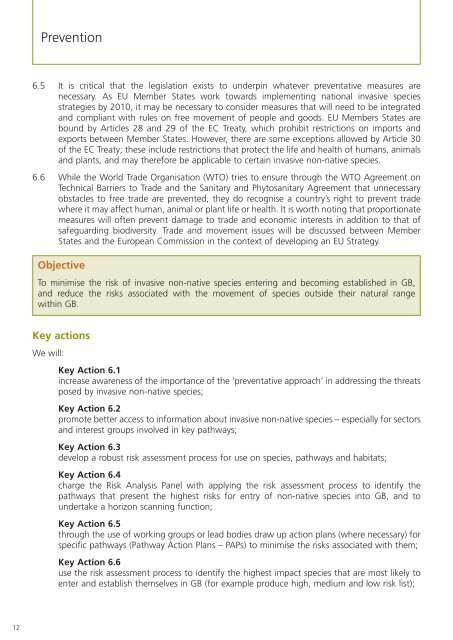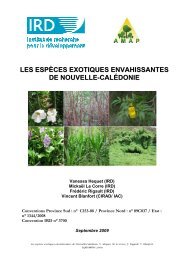The Invasive Non-Native Species Framework Strategy for ... - Defra
The Invasive Non-Native Species Framework Strategy for ... - Defra
The Invasive Non-Native Species Framework Strategy for ... - Defra
Create successful ePaper yourself
Turn your PDF publications into a flip-book with our unique Google optimized e-Paper software.
12<br />
Prevention<br />
6.5 It is critical that the legislation exists to underpin whatever preventative measures are<br />
necessary. As EU Member States work towards implementing national invasive species<br />
strategies by 2010, it may be necessary to consider measures that will need to be integrated<br />
and compliant with rules on free movement of people and goods. EU Members States are<br />
bound by Articles 28 and 29 of the EC Treaty, which prohibit restrictions on imports and<br />
exports between Member States. However, there are some exceptions allowed by Article 30<br />
of the EC Treaty; these include restrictions that protect the life and health of humans, animals<br />
and plants, and may there<strong>for</strong>e be applicable to certain invasive non-native species.<br />
6.6 While the World Trade Organisation (WTO) tries to ensure through the WTO Agreement on<br />
Technical Barriers to Trade and the Sanitary and Phytosanitary Agreement that unnecessary<br />
obstacles to free trade are prevented, they do recognise a country’s right to prevent trade<br />
where it may affect human, animal or plant life or health. It is worth noting that proportionate<br />
measures will often prevent damage to trade and economic interests in addition to that of<br />
safeguarding biodiversity. Trade and movement issues will be discussed between Member<br />
States and the European Commission in the context of developing an EU <strong>Strategy</strong>.<br />
Objective<br />
To minimise the risk of invasive non-native species entering and becoming established in GB,<br />
and reduce the risks associated with the movement of species outside their natural range<br />
within GB.<br />
Key actions<br />
We will:<br />
Key Action 6.1<br />
increase awareness of the importance of the ‘preventative approach’ in addressing the threats<br />
posed by invasive non-native species;<br />
Key Action 6.2<br />
promote better access to in<strong>for</strong>mation about invasive non-native species – especially <strong>for</strong> sectors<br />
and interest groups involved in key pathways;<br />
Key Action 6.3<br />
develop a robust risk assessment process <strong>for</strong> use on species, pathways and habitats;<br />
Key Action 6.4<br />
charge the Risk Analysis Panel with applying the risk assessment process to identify the<br />
pathways that present the highest risks <strong>for</strong> entry of non-native species into GB, and to<br />
undertake a horizon scanning function;<br />
Key Action 6.5<br />
through the use of working groups or lead bodies draw up action plans (where necessary) <strong>for</strong><br />
specific pathways (Pathway Action Plans – PAPs) to minimise the risks associated with them;<br />
Key Action 6.6<br />
use the risk assessment process to identify the highest impact species that are most likely to<br />
enter and establish themselves in GB (<strong>for</strong> example produce high, medium and low risk list);





